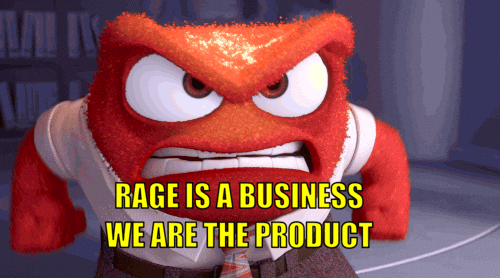
3 Reasons We Are All Outraged
Share
The Rise of Outrage-Based Business Models and Our Societal Divide

In the past few decades, our society has become increasingly polarized, with outrage and division seemingly dominating every conversation. From social media feeds to cable news, it feels like we’re constantly bombarded with shocking headlines, partisan narratives, and emotionally charged content. But how did we get here? The answer is complex and lies in the confluence of the evolution of our media landscape, the explosion of information distribution systems, and unintended consequences of the digital age.
But all of that can be boiled down to a very simple to; Business Interests & Political Agendas.
1 - The Shift to For-Profit Culture Wars
To understand our current societal divide, we need to go back to the mid-1980s through the early 2000s. During this period, the media landscape underwent a dramatic transformation. Cable news, talk radio, and print media began to prioritize sensationalism over substance. Why? Because outrage sells. The more shocking, divisive, or emotionally charged a story was, the more eyeballs it attracted—and the more ad revenue it generated.
But this has always been true, why was there a sudden spike in shock and sensation across the entire media landscape?
This era also saw the deregulation of media, leading to massive corporate consolidation. A handful of corporations and wealthy individuals gained control over major media outlets, and as Wall Street/Investment Banking was also undergoing deregulation our entire economic existence was shifting to intense immediate short-term profits and gains for shareholders. This business model incentivized sensationalizing news, using dramatic headlines, intense music, and partisan spin to grow and engage audiences faster and larger than ever. Critical but less "exciting" information and moderate non-partisan delivery was de-prioritized in favor of stories and coverage that could drive ratings and ad dollars.
2 - The Digital Revolution and the Decline of Traditional Journalism
Enter the "Age of Information." If the consolidation of traditional media was a house fire, the rise of the internet and digital media was a raging wild fire, and the fire hydrants ran dry.
New Media" decimated the traditional journalism model. Newsrooms shrank, investigative reporting became a luxury, and the race to publish content faster and cheaper became the norm. As with traditional media, ad-dollars were/are the bedrock of digital publishing. And the internet opened the flood gates for advertising potential. Anyone could target any demo or audience, and thus veracity was longer of much interest to those publishing content, only clicks. The more content, the more clicks. The more headlines, the more clicks. The more sensation, the more clicks. The more shares, the more clicks. The only thing that matters is publishing click-worthy content. And getting clicks is not about context, veracity, or vetting, it is all about fast emotional reactions.
New digital outlets sprung up like weeds and quickly realized that ethical journalism, fact-checking, sourcing, editorial oversight, and general standards and practices were not only unnecessary, they were expensive and time-consuming. Instead, they invented a new model for creating and distributing information; the Content Mill.
For every outlet that attempted to abide by traditional standards and practices for news gathering/reporting, journalism, or just plain infotainment, a dozen more operated as content mills - platforms that churn out vast quantities of low-effort, speedy, clickbait-driven content written by inexperienced dirt cheap freelancers.
Companies who describe themselves as digital publishers while actually functioning as ad-sales and data analytics firms (like Valnet, Red Ventures, G/O Media Inc., Keleops, and many more) own dozens of digital "brands" that function as content factories.
These companies prioritize quantity over quality, using sensational headlines, misleading thumbnails, and emotionally charged language to drive clicks. The result? A flood of content that is often devoid of real information, intentionally partisan, or outright misleading.

3 - Social Media: The Nuclear Explosion of Outrage
Now we are living in the "Age of Content." If the rise of digital media was a wild fire, then the rise of social media was the nuclear explosion that supercharged our societal divide.
Social media platforms were initially designed as a way of people to connect. But they quickly evolved into information distribution networks driven by profit via advertising.


Here’s a rundown of how they’ve contributed to our outrage and division:
-
Removed Barriers to Entry: Anyone can create and share content, regardless of its accuracy or intent. This democratization of information has its benefits, but it also means misinformation and propaganda can spread like wildfire. Especially when created by bad actors with means, boosted by inauthentic "organic accounts" and supported by third party "engagement services." These all include be people, bots, and A.I.
-
Monetized Content: Social media platforms incentivize users to create as much content as possible. The more engagement a post gets, the more money it can generate through ad revenue, sponsorships, or affiliate marketing.
-
Perfected Algorithms: Platforms use sophisticated algorithms to maximize engagement. These algorithms prioritize sensational, emotionally charged, and partisan content because it keeps users scrolling, clicking, and sharing. In a society already primed for outrage and divided by two decades of culture war across media this has created a feedback loop of exponentially ever-increasing polarization.
-
Exploited Human Psychology: Social media companies have consulted psychologists and conducted countless tests to figure out what keeps users engaged. The answer? Content that elicits fast, emotional reactions—outrage, shock, anger, and fear. These emotions drive higher engagement, making them the bedrock of the social media economy.
-
Personalized Echo Chambers: Algorithms personalize content based on user behavior. They send users with similar behaviors certain content that will create fast reactions and thus engagement. And they send other users different content that will create create fast reactions/engagement. These different echo chambers only expose people to information that aligns with their existing beliefs. In a rage-based culture war economy, this means different groups are fed completely different narratives about the same news and events. The people in different echo chambers are functionally living in different realities. Different versions of facts, truth, blame, etc., making it nearly impossible for people to find common ground.
The Consequences: A Divided Society
The combination of sensationalized media, profit-driven content mills, and algorithmically amplified outrage has had profound consequences. We’ve become a society where:
-
Critical thinking is sidelined: Media literacy has never really existed, and when there were only a small handful of outlets delivering more or less the same basci info with more or less a moderate non-partisan POV, this was not an issue. But not with tens of thousand of outlets, influencers, podcasts, and socials inundating us all 24/7/365 with an endless deluge of content society as a whole is left ill-equipped to discern credible information from misinformation. Bias vs Agenda. Propoganda vs Facts.
-
Trust in institutions erodes: When every news outlet seems to have an agenda, it’s easy to dismiss all information as biased or fake. Even when traditional media outlets still utilize basic standards and practices in professional news gathering and reporting, even a hint of partisan bias is enough to send people over the top if it doesn't easily align with their version or reality.
-
Dialogue breaks down: Competing realities make it impossible for people to have productive conversations, let alone find solutions to shared problems.
-
Outrage becomes the norm: Constant exposure to shocking, divisive content leaves people feeling perpetually angry, anxious, and disconnected.
Is There a Way Out?
The path forward won’t be easy, but it starts with recognizing the root of the problem: our information ecosystem. We need to:
-
Promote Media Literacy: Teach people how to critically evaluate information, identify bias, and recognize misinformation.
-
Support Ethical Journalism: Invest in news outlets that prioritize accuracy, accountability, and investigative reporting over sensationalism.
-
Hold Platforms Accountable: Push social media companies to reform their algorithms and business models to prioritize quality over quantity and connection over division.
-
Demand Transparency: Advocate for greater transparency in how content is created, distributed, and monetized.
Our societal divide isn’t inevitable—it’s the result of choices made by media companies, tech platforms, billionaire owners, and policymakers. By addressing the root causes of our information crisis, we can begin to rebuild trust, foster dialogue, and create a healthier, more informed society.
The question is: are we willing to do the work?




